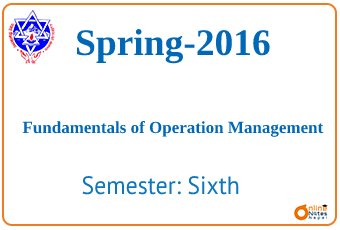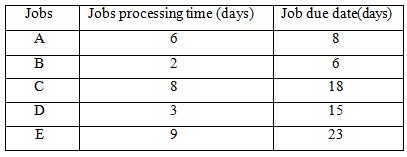Published by: sadikshya
Published date: 27 Jun 2021

This is the question set along with answers of Fundamentals of Operation Management Spring2016, which was taken by the Pokhara University.
Pokhara University – Fundamentals of Operation Management Spring2016
| Level: Bachelor | Semester –Spring | Year: 2016 |
| Program: BCIS\BBA | Full Marks: 100 | |
| Course: Fundamentals of Operation Management | Pass Marks: 45 | |
| Time: 3hrs. | ||
Section “A”
Very Short Answer Questions
Attempt all the questions.
Section “B”
Descriptive Answer Questions
Attempt any six questions
11.Prepare a flowchart and service blueprint for the following
a) A hotel
b) The registration process at a hospital
12.Following are the figure of defectives in 22 lots each containing 2,000 rubber belts
425, 430, 216, 341, 225, 322, 280, 306, 337, 305,356,
402, 216, 264, 126, 409, 193, 326, 280, 389, 451,420
Draw control chart for fraction defective and comment on the state of control of the process.
13.Define the Bullwhip effect. What are the issues that need to be considered while selecting suppliers for an effective supply chain management?
14. How can competitive advantages be gained through operation? Illustrate with real world examples.
15. A company has five jobs waiting processing. Processing time and due dates are given in the table.

In what sequence would the jobs be ranked according to the following rules:
a) FCFS
b) SPT
Which decision is best and why?
16. What are the major assumption and requirement of JIT? Is JIT system possible to implement in country like Nepal?
17. Jamunastore stocks toy race cars. The store has been given a quantity discount schedule for these cars. This quantity schedule is shown below.

The normal cost of the toy car is $5. Ordering cost is $49 per order, annual demand is 5000 race cars, and inventory carrying cost as a percent of price is 20%. What order quantity will minimize the total inventory cost?
Section “C”
Case Analysis
18.Read the following case carefully and answer the questions that follow.
Hazel had worked for the same Fortune 500 company for almost 15 years. Although the company had gone through some tough times, things were starting to turn around. Customer orders were up, and quality and productivity had improved dramatically from what they had been only a few years earlier due to a companywide quality improvement program. So it came as a real shock to Hazel and about 400 of her coworkers when they were suddenly terminated following the new CEO’ decision to downsize the company.
After recovering from the initial shock, Hazel tried to find employment elsewhere. Despite her efforts, after eight months of searching she was no closer to finding a job than the day she started. Her funds were being depleted and she was getting more discouraged. There was one bright spot, though: She was able to bring in a little money by mowing lawns for her neighbors. She got involved quite3 by chance when she heard one neighbor remark that now that his children were on their own, nobody was around to cut the grass. Almost jokingly, Hazel was mowing the lawns of five neighbors. Other neighbors wanted her to work on their lawns, but she didn’t feel that she could spare any more time from her job search.
However, as the rejection letters began to pile up, Hazel knew she had to make a decision. On a sunny Tuesday morning, she decided, like many others in a similar situation, to go into business for herself-taking care of neighborhood lawns. She was relieved to give up the stress of job hunting, and she was excited about the prospect of being completely on her own boss. But she was also fearful of being completely on her own. Nevertheless, Hazel was determined to make a go of it.
At first, business was a little slow, but once people realized Hazel was available, many asked her to take care of their lawns. Some people were simply glad to turn the work over to her; others switched from professional lawn care services. By the end of her first year in business, Hazel knew she could earn a living this way. She also performed other services such as fertilizing lawns, weeding gardens, and trimming shrubbery. Business become so good that Hazel hired two part-time workers to assist her and, even then, she believed she could expand further if she wanted to.
Questions